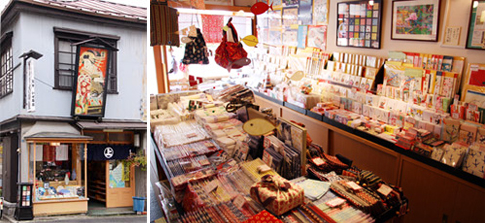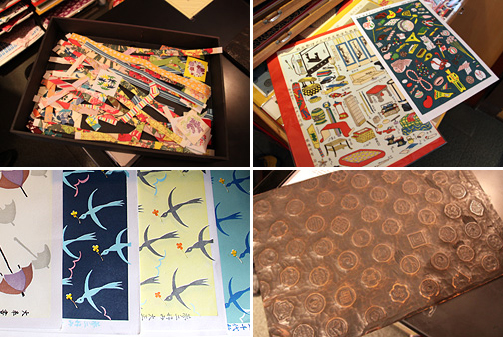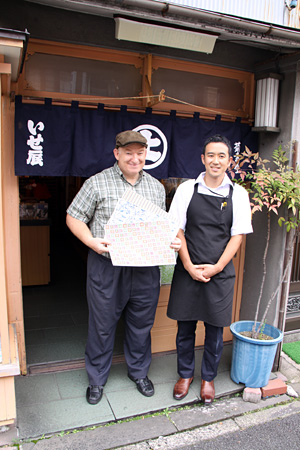 |
セインさん。今回、ご案内するのは谷中にある「いせ辰」、江戸千代紙の老舗です。たしか、セインさんの学校のすぐ近くなんですよね。
This time, Thayne-san, I’ll be introducing you to Isetatsu, in Yanaka. It’s an Edo chiyogami shop. |
|
|
 |
はい。ご近所さんなんです(笑)。今日は、お話ができるのを楽しみにしてきました。
Well, that’s in my neighborhood. I’ve been looking forward to today. |
|
|
| (高橋) |
ようこそ、セインさん。高橋元人です。
Hello, Thayne-san. I’m Takahashi Gento. |
|
|
|
 |
|
|
 |
こんにちは、高橋さん。セインです。
浮世絵の大きな看板が目立っていますね。先ほども外国のお客様がいましたが、つい入りたくなるようなお店ですね。
Hi, Takahashi-san.
I’m Thayne.
Your ukiyoe sign is hard to miss. I noticed some foreigners in your shop a moment ago. This kind of shop really draws you in, doesn’t it. |
|
|
| (高橋) |
ありがとうございます。ほんとうに外国のお客様が多いんです。
Thank you. We really do get a lot of non-Japanese customers. |
|
|
 |
お店の中は千代紙と紙製品でいっぱいですが、江戸千代紙はだいたい何種類くらいあるんですか?
Your shop is full of chiyogami and things made with it! About how many kinds of Edo chiyogami do you have? |
|
|
| (高橋) |
デザインで数えると100種類。色違いも合わせると500種類ほどです。 千代紙というのは和紙に木版でいろいろな色や柄を手摺りした紙ですが、もとは宮中で始まったようです。京都の京千代紙は着物の模様のような伝統的なデザインで、優雅な色合い。それに対して、江戸千代紙は歌舞伎などの影響を受けて、赤・黄・緑といった原色を多用した華やかな色柄が多いのが特徴です。
簡単に言えば、千代紙の柄は、着物の柄。着物をいくつも買えない庶民が、千代紙の着物を人形に着せて遊んだんです。
We have about 100 different designs, but if you count color variations it comes to about 500. Chiyogami is Japanese paper (washi) printed with different colors and patterns using woodblocks The Kyo-chiyogami of Kyoto are traditional designs like that on a kimono, and the blend of colors is very elegant. Edo chiyogami, on the other hand, was influenced by kabuki, and is characterized by lots of bright colors and patterns, with liberal use of reds, yellows and greens.
Basically, the patterns used for chiyogami are the same as those of the kimono, but since commoners couldn’t afford to buy very many kimono, they settled for dressing dolls in kimono of chiyogami. |
|
|
 |
きれいですね!
They’re beautiful! |
|
|
| (高橋) |
江戸時代の文様だけではなくて、明治の後期から大正時代にかけて活躍した画家・竹久夢二にデザインさせた千代紙などもあるんですよ。
In addition to traditional patterns from the Edo period, we also have chiyogami designed by artists active from the end of the Meiji period through the Taisho Period. |
|
|
 |
わー、これは可愛いですね。そして、とっても斬新でおしゃれですね。
Wow, this is really cute. It’s so original and stylish. |
|
|
|
 |
|
|
| (高橋) |
はい。とても人気があります。 そして、千代紙の楽しいところは、1枚の絵として額に入れて飾って見てもいいんですが、人形の着物にしたり、箱に貼るなどして使った残り端だけ見ても、きちんとデザインになっているところです。それをパッチワークのように他の絵柄と合わせて使ってもきれいで、捨てるところがないんです。
Yes, that one’s quite popular. What’s fun about chiyogami is that while you can put one piece in a frame and enjoy it like that, you can also fold them into kimono for dolls, and paste leftover pieces onto boxes and, so on. However you use it, it makes a neat design. Combining different designs like patchwork also looks nice. Nothing’s wasted. |
|
|
 |
組み合わせることで、また思いがけない美しさが生まれるんですね。絵柄がデザインとして洗練されているんですね。
Combining designs reveals a totally unexpected beauty, doesn’t it? The patterns give it a refined look. |
|
|
| (高橋) |
はい。江戸千代紙は、基本的には浮世絵と同じ工程で作られるんです。つまり、絵師が「絵を描き」、彫り師がそれを木に「彫って」版を作り、摺り師が和紙に「摺って」出来上がります。それぞれを担当する職人のセンスと高い技術があって生まれるので、芸術作品ではないのですが、芸術性が高いんです。たとえば、色の濃淡で遠近などを表現したりもしていますが、これは摺り師の腕にかかっているんです。
そして、絵師、彫り師・摺り師を束ねて、そういう作品を作ってきたのが、版元。当店のご先祖様たちです。
Edo chiyogami is basically made using the same process as that for ukiyoe. The painter paints the design, the sculptor carves the picture into the wood, forming the woodblock, and finally the printer prints the design onto Japanese paper. The artisan in charge of each step of the process needs to have a good artistic sense and be highly skilled, so although chiyogami is not fine art, a lot of craftsmanship goes into it. For example, gradations of color are used to show depth, and this really depends on the skill of the printer.
Finally, the publisher is who brings the painters, sculptors and printers all together―as our founding fathers did. |
|
|
 |
いせ辰さんは、いつ頃の創業なんですか?
When did Isetatsu first open its doors? |
|
|
| (高橋) |
江戸末期の元治元年(1864)に、日本橋堀江町に、初代が錦絵と団扇(うちわ)の問屋を開きました。その後、明治3年、2代目の時に神田弁慶橋に移転すると、文明開化に注目して、築地の居留地や横浜の外国商館に千代紙細工や錦絵などを売り込んで、欧州にも輸出しました。続く3代目も神田っ子ならではの粋な人だったようで、芸能に通じ、多彩な人々と交流をもちながら店を発展させていきました。 ところが大正12年(1923)の関東大震災で、コレクションはもちろん、店の命綱である千代紙の版木も、すべて失います。一時は途方にくれますが、3代目は子どもや弟子たちとともに約1000種類の千代紙版画を復活していきました。また、昭和17年(1942)には地盤が固い現在地に移りました。 でも、災難はこれで終りではなく、第2次世界大戦で、また店が焼失。今度は全財産を失います。幸い、疎開してあった千代紙版木がありましたので、それを復刻しながら、また裸一貫から店を立て直していったのが4代目です。
In the first year of Genji (1864), at the end of the Edo period, the first generation of the business opened a color woodblock print and uchiwa (Japanese fan) wholesale shop in Horie-cho in Nihonbashi. Later, in the third year of the Meiji period, the second-generation owner moved the shop to Benkeibashi in Kanda. The shop received lots of attention during the Westernization movement, and sold chiyogami articles and color woodblocks in the foreigner’s district in Tsukiji and to foreign companies in Yokohama, and even exported items to Europe. Apparently, the third-generation owner was of a refinement only found amongst the locals of Kanda, and grew the business through his many contacts in the performing arts. However, in the Great Kanto Earthquake of the 12th year of Taisho (1923), we lost all the chiyogami woodblocks, the very lifeblood of our store, and of course our entire collection of chiyogami. For a time, we didn’t know what to do, but the third generation’s children and apprentices were able to help replicate about a thousand of the chiyogami woodblocks. Also, in the 17th year of Showa (1942), the shop moved to its present location on firmer land. Unfortunately that wasn’t the last of the disasters―during World War II, the shop was destroyed by fire, and we lost everything. Thankfully, some of the woodblocks had been evacuated, and by copying those the fourth generation rebuilt the shop from nothing. |
|
|
 |
わー、もったいない!
Goodness, what a terrible loss! |
|
|
 |
大変な苦労の歴史があったんですね。
I can see your shop has gone through plenty of tough times. |
|
|
| (高橋) |
昔の資料や版木が焼失したため、江戸や明治に作られた千代紙のすべて見ることができないのは本当に残念ですね……。
そういえば、最近のことですが、ゴッホの『ダンギー爺さん』という有名な絵の中に、うちの千代紙が出ていることを、研究者の方から教えてもらいました。
It’s really a shame that we can’t show you all the chiyogami made in the Edo and Meiji periods, since our woodblocks and reference materials from that time were all lost to fire. Incidentally, I was recently was told by an expert that our chiyogami appears in van Gogh’s famous Portrait of Pere Tanguy. |
|
|
 |
すごい! ゴッホが描いたなんて!
Wow, drawn by van Gogh! |
|
|
 |
ゴッホは浮世絵の大ファンになって、模写などもしていますが、いせ辰さんの千代紙もお気に入りだったんですね。2代目、3代目といったご先祖様たちが知ったら、喜ばれたでしょうね。
Van Gogh became a big fan of ukiyoe and made his own imitations, and apparently he liked the chiyogami of Isetatsu. If the second and third generation owners knew that, they would have been very pleased, I’m sure. |
|
|
| (高橋) |
そう思います。特に3代目は私生活のすべてを芸能や芸術などにかけて、必死で遊んだ人だったそうですから大喜びしたでしょうね。成田屋の「かまわぬ」という柄の使用を許してもらったのも、3代目の交友の中から生まれたと聞いています。 私がいま、こうしてこの店にいて、この商売をやることができているのは、そうした先祖の人たちのおかげなんだなあと本当に感謝しているんです。
I think you’re right. The third-generation owner would have been especially pleased since he spent all his personal life in the world of entertainment and the arts and, from what I hear, he was quite the socialite. The fact that the kabuki actor Naritaya gave us permission to use his trademarked logo “kamawanu” in our chiyogami designs also was born out of the friendships cultivated by our third-generation owner, so I hear. I feel really thankful for the shop’s founders because if it weren’t for them, I wouldn’t be here in this shop, employed in this business. |
|
|
  |
代々が、ちゃんとつながっているんですね。
Your shop sure has strong generational ties. |
|
|
| (高橋) |
現在は、5代目にあたる4人の兄妹が、それぞれの役割を担って暖簾を守っています。
Today, as the fifth generation, my three siblings and I each have a role to play in preserving its reputation. |
|
|
 |
いいですね。夜の浅草ですか。そういえば、僕もここに来るのは昼間ばっかりです。次は夜に来ようかな。
That’s a great idea. Asakusa at night! Come to think of it I’ve always been here during the daytime as well. Next time maybe I’ll visit at night. |
|
|
  |
今日はいいお話をありがとうございました。
Thank you so much for your time today. |
|
 |
|
(文)太田美代
(英訳)デイビッド・A・セイン |
 1959年、米国生まれ。証券会社勤務を経て来日し、翻訳・通訳など多岐にわたって活躍。豊富な教授経験を生かし、数多くの英語関係書籍を執筆。近著に『日本人のチョットへんな英語』(アスコム)、『超入門シャドーイング』(主婦の友社)、日本人が使いすぎる英語(PHP文庫)など多数。
1959年、米国生まれ。証券会社勤務を経て来日し、翻訳・通訳など多岐にわたって活躍。豊富な教授経験を生かし、数多くの英語関係書籍を執筆。近著に『日本人のチョットへんな英語』(アスコム)、『超入門シャドーイング』(主婦の友社)、日本人が使いすぎる英語(PHP文庫)など多数。









